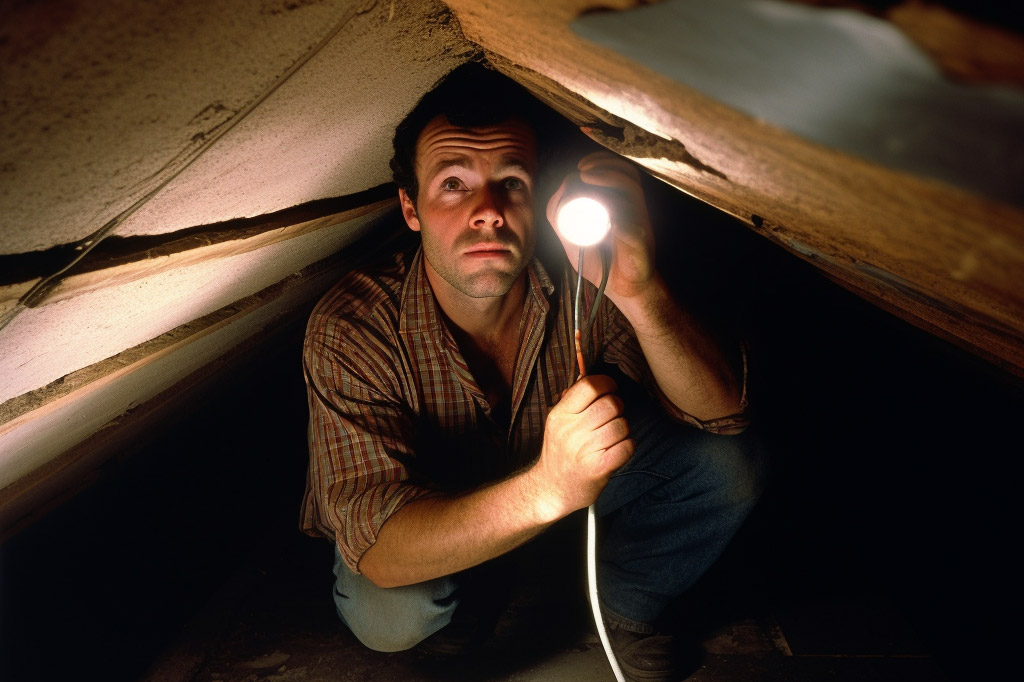A leaking roof is a homeowner’s nightmare. The potential for costly damages and the headache of dealing with the aftermath can be overwhelming. However, it’s possible to address small leaks from the inside of your home, buying you time to plan for a more permanent solution. In this guide, we will walk you through the process of fixing a leaking roof from the inside, step by step.
Is it Possible to Fix a Roof Leak From Inside the House?
Contrary to popular belief, you can fix a small roof leak from inside your home, particularly if you have access to the attic. It’s important to note that this is usually only a temporary solution to prevent further damage. A professional inspection and repair should follow to ensure the long-term integrity of your roof.
While fixing a roof leak from the inside is possible, it’s essential to understand the limitations of this approach, particularly during periods of heavy rain. The success of a temporary repair depends on the size and severity of the leak, type of roof construction, the amount of water damage, as well as the reason for the leak. For example, small leaks caused by a few missing shingles or minor punctures can be temporarily patched from the inside, even when rain is a contributing factor. However, more extensive issues, such as widespread water damage, structural problems, or a leaking roof membrane, especially during heavy rainfall, will require professional attention and repairs from the exterior. It’s crucial to recognize when a temporary fix is insufficient and seek expert help to address the root cause of the leak and protect your home in the long run, regardless of the weather conditions.
Missing or damaged roof tiles are best fixed from the exterior of the house and are therefore outside the scope of this guide. Depending on the situation, a missing or damaged nail (or other fastener) should be repaired in the same direction it was installed.
While addressing roof repairs from the inside, it’s essential not to overlook the role of ‘flashing’ in preventing leaks. Flashing consists of thin metal strips, typically made of aluminium or galvanised steel, installed at the joints and vulnerable areas of the roof, such as around chimneys, vents, skylights, and valleys. Flashing functions as a critical barrier, diverting water away from these points and preventing it from seeping into your home.
When fixing roof repairs from the inside, it’s crucial to inspect the flashing for any signs of damage or deterioration, such as rust, corrosion, or dislodged sections. Damaged flashing may compromise your repair efforts and allow water to continue leaking into your home. If you discover issues with the flashing, it’s important to consult a professional roofing contractor to assess and repair or replace the affected areas as needed. Proper flashing maintenance and repair are vital to the overall success of your roof repair efforts, ensuring a watertight seal and protecting your home from leaks in the long run.
Fixing a Leaking Roof From the Inside an Attic: A Step-by-Step Guide
Step 1: Remove Standing Water and Insulation
Firstly, grab a flashlight, then upon entering the attic or roof space, remove any insulation covering the affected area of the drywall. Use sponges, a bucket, or towels to soak up standing water. Avoid placing your weight on the wet drywall, as it may collapse. Instead, use a piece of plywood to distribute your weight across the ceiling joists.

Step 2: Identify the Source of the Leak
Locating the source of a leak can be a complex task, as water often follows a winding path along rafters, beams, or other structural elements before eventually dripping onto the ceiling or wall, causing visible damage. To find the origin of the leak, carefully examine the water trail, starting from the wet area on the drywall and tracing it back to where it enters the underside of the roof.
If you’re having difficulty pinpointing the leak’s source, it’s crucial to inspect other potential causes, such as clogged gutters. Blocked gutters and downspouts can accumulate debris like leaves, twigs, and dirt, preventing proper water drainage. As a result, water may overflow and seep into the roof space, leading to leaks and damage. Regularly cleaning and maintaining your gutters can help prevent such issues and keep your roof in good condition.
In addition to checking the gutters, consider examining the flashing, vents, and other roof penetrations where water might find its way in. Keep in mind that some leaks may only be visible during or shortly after a rainfall, so it’s helpful to inspect your roof during different weather conditions.
Remember that if you’re unable to locate the source of the leak or if the problem persists despite your efforts, it’s advisable to consult with a professional roofing plumber. They can thoroughly assess the situation and provide an effective, long-lasting solution to protect your home from water damage.

Step 3: Patch the Leak
Once you’ve identified the leak’s source, wait for the area to dry. During this time, you can prepare the necessary tools and materials for the repair, including roofing tar, bitumen paint, or a suitable sealant. Sealants, such as silicone or polyurethane-based products, can provide an additional layer of protection against water penetration.
When the area is dry, use a putty knife to apply a generous layer of your chosen material—roofing tar, bitumen paint, or sealant—over the leak.
Press a shingle firmly onto the applied material, ensuring that it adheres well and covers the leak.
To enhance the effectiveness of the repair, apply additional tar, paint, or sealant around the shingle’s edges, creating a watertight seal.
To simplify future repairs and help professionals locate the patched area, use chalk to circle the repaired spot. By incorporating sealants into your temporary repair, you can improve the leak’s coverage and increase the effectiveness of the patch until a more permanent solution is implemented.
The above video demonstrates the use of Flex Seal spray which can be used as a temporary solution for minor leaks whilst you wait for a proper repair to be completed by a roofing expert.
Risks associated with limited access spaces
Working in confined spaces like attics to repair a leaking roof presents its own set of risks and challenges. Navigating limited space and maneuvering around obstacles can be difficult and potentially dangerous for inexperienced individuals. Moreover, attics often have poor lighting, making it harder to identify and address the source of the leak. Additionally, there may be electrical wiring, ventilation systems, or insulation materials present, which could pose safety hazards if not handled properly.
Due to these factors, it’s highly recommended that homeowners seek the help of professional roof plumbers or roofing contractors who have the experience, tools, and expertise to safely and effectively repair roof leaks in confined spaces such as attics. By relying on professionals, you can avoid potential injuries and ensure the long-term integrity of your roof.
How do you stop a concrete roof from leaking from the inside?
Over time, concrete is susceptible to damage, including cracks and gaps that allow water to seep through, leading to leaks. In less severe cases, you can tackle minor roof repairs potentially from the inside, yourself.
To do this, gather the necessary materials, including mortar or roof cement, roof primer, and an elastomeric sealant. Start by thoroughly cleaning the entire roof surface, using a pressure washer to eliminate all debris and grime, such as dust, dirt, branches, and leaves. Next, fill any cracks or holes with mortar or roof cement to create a solid base. Afterwards, apply a layer of roof primer, allowing it to dry completely. Once the primer is dry, cover the cracks, holes, corners, and other damaged areas with an elastomeric sealant, creating a waterproof barrier. To strengthen the seal, apply a second coating the following day, ensuring maximum protection against leaks.
Estimating the Cost of a Temporary Roof Leak Repair
The materials required for a temporary roof leak repair, such as shingles, roofing tar, or bitumen paint, are relatively inexpensive. A one-litre container of tar or paint should cost around $40 or less at most hardware stores. If you need to purchase a tool to assist with the repairs this will naturally add to the cost as well. Keep in mind that a temporary fix is not a long-term solution, and more costly professional repairs will likely be necessary.
Emergency Roof Leak Solutions
In the event of a roof leak emergency, addressing a leak quickly can prevent further damage. Fixing a roof leak from the inside is usually only a temporary solution and if there is a considerable amount of water pouring in which constitutes an emergency (in order to save damage to your property or possessions), you are better off ensuring the root cause is addressed properly as many temporary measures will fail quickly under considerable load. A more durable and weather-resistant roofing system may be necessary to avoid future leaks and costly repairs.
Conclusion
Fixing a leaking roof from the inside is a viable temporary solution for small leaks. By following this step-by-step guide, you can mitigate water damage and buy yourself time to plan for a professional repair. Remember, a temporary fix is not a long-term solution, it is a result that buys you more time, so always consult with a professional to ensure the integrity of your roof.
